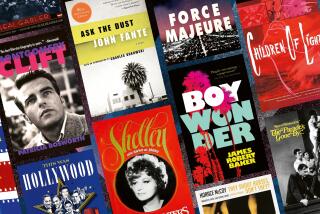Christopher Isherwood, Whose Tales Inspired ‘Cabaret,’ Dies
- Share via
Author and dramatist Christopher Isherwood, who chronicled his own life with unsparing detachment and whose tales of expatriates scrabbling amid the artistic and political chaos of 1930s Berlin were later the basis for the musical and film version of “Cabaret,” died Saturday at his Santa Monica home. He was 81.
Isherwood, who had been seriously ill in recent months from cancer, died at about 11:15 a.m., according to Don Bachardy, an accomplished portrait painter and Isherwood’s companion for 33 years.
Friends of the ailing novelist said Isherwood, who had mined his life in several autobiographical sketches and memoirs, had begun work on a new volume. “He always kept writing,” Bachardy said.
The work that won him the most fame was “Goodbye to Berlin,” a 1939 book of short stories later popularized by John van Druten’s play “I Am a Camera,” and by the Broadway musical and film versions of that play, “Cabaret.”
The book, set in Berlin’s decadent cafes and strife-ridden streets as the Nazis rose to power in the early 1930s, also was Isherwood’s first use of a cool, machine-like narrator, who introduced the book with the passage, “I am a camera with its shutter open, quite passive, recording, not thinking.”
“He was the kind of writer who wrote very close to the bone,” said novelist Gavin Lambert, a close friend. “He found his own life his best subject. He wrote with complete honesty and with a clarity of style that few of us possess.”
An acknowledged homosexual and a devout disciple of the Hindu philosophy of Vedanta, Isherwood’s uncompromising self-portraits bore in often in his later years on sexual and religious themes. “I have written about homosexuals in my novels,” he said in 1972, “and in taking up the cause of one minority, that of homosexuals against the dictatorship of heterosexuals, I have spoken out for all minorities.”
A British expatriate who became a naturalized U.S. citizen after settling in California during World War II, Isherwood was among a close circle of Cambridge-educated writers and critics that included the poets W. H. Auden and Stephen Spender. Isherwood collaborated with Auden on three plays and an account of the 1938 war between China and Japan. And Isherwood carried on a lively correspondence with Spender.
Despite those ties, Isherwood forged his own path, blending his experiences and fiction in a pioneering, if not always successful, literary style. “That kind of writing is very in vogue now,” said Lambert, the author of “Inside Daisy Clover.” “He was doing ‘faction’ long before anybody else.”
Isherwood was born to upper-middle-class parents on Aug. 26, 1904, in Wyberslegh Hall in rural Cheshire. His father, Francis Bradshaw-Isherwood, was an amateur actor and musician and an officer in the British army who died in 1915 at the battle of Ypres during World War I.
Isherwood’s parents encouraged his literary talents early in his childhood. His mother urged him to write stories about his friends while his father acquainted him with the theater. “I used to have a toy theater and the first things I wrote were stories for that theater,” Isherwood said in a 1980 interview.
His lifelong friendship with Auden began when the two met while attending St. Edmunds School in Surrey.
By the time he entered Cambridge University in 1924 on a history scholarship, Isherwood was already uneasy with convention. His rebellious nature got him expelled from Cambridge after he answered questions in his exams in scurrilous limericks and blank verse.
Stephen Spender, who met him at Cambridge, later said Isherwood was “more than a rebel passing through a phase of revolt against parents, conventional morality and orthodox religion. He also recognized that nearly everyone wanted something out of life that he or she had been taught to conceal.”
Thoughts of Medicine
Isherwood flirted with the idea of becoming a doctor, but by the age of 24 he wrote his first novel, “All the Conspirators,” a book about family tragedy and neurotic illness. It was the first of 25 books.
Praise was not unanimous for Isherwood’s first several novels, but his prose attracted the attention of some of England’s most important literary voices. Cyril Connolly, the influential London Sunday Times reviewer, said Isherwood was “the hope of English fiction.” “That young man,” author Somerset Maugham told Virginia Woolf in 1938, “holds the future of the English novel in his hands.”
But it was not until Isherwood left London in 1929 to visit Auden in Berlin that he found a subject to match his precocity. He stayed on in Berlin after Auden left, subsisting on a meager salary he obtained by teaching English and spending it in cabarets.
It was a time of both artistic and personal liberation for Isherwood, taking place while the shaky political institutions of Weimar Germany teetered toward Nazism. “For Christopher,” Isherwood wrote of himself later in the third person, “Berlin meant Boys.”
Hitler’s Rise to Power
He stayed on in Berlin until 1933, when Hitler came to power, and spent the next years traveling in Europe and writing in England. What came out of his experiences was “Goodbye to Berlin,” a 1939 book which consisted of six stories about expatriates, artists and entertainers in decaying, chaotic mid-1930s Berlin.
The Berlin stories introduced Sally Bowles, an expatriate entertainer who later became a major character in the Broadway musical and film “Cabaret.” The tales also introduced Isherwood as his own narrator, a character detached from those around him and whose life blended the real and the imaginary.
It was a literary device that would reappear frequently in Isherwood’s later writings. Yet despite the enduring popularity of the Berlin stories, Isherwood and many critics valued his later works more highly. “The whole phenomenon of Nazi Germany continues to fascinate us,” Lambert said. “I think that’s why they remain so popular. But he did feel that the Berlin stories came to overshadow his later work.”
Two of Isherwood’s novels from the 1960s, “Down There on a Visit” (1962) and “A Single Man” (1964), are highly regarded. The first novel consists of episodes in Germany, Greece, England and California linked by a single narrator. “A Single Man” is a short novel about a middle-aged English-born college professor left alone by the death of a longtime homosexual companion.
Settles in L.A.
By the time he wrote those novels, Isherwood had fled Europe with Auden, arriving in the United States in 1939. Isherwood settled in Los Angeles to work on screenplays and join an immigrant community that included such literary lights as Thomas Mann, Aldous Huxley and Bertolt Brecht. Although most of his scripts were not filmed, he worked with writer Terry Southern on the screenplay of “The Loved One,” English author Evelyn Waugh’s mordant look at British expatriates and funeral homes in Southern California.
During the war years, Isherwood took up residence in Santa Monica with Don Bachardy, an accomplished artist whose works are hung in the National Portrait Galley in London and whose portrait of Auden is in the Museum of Modern Art in New York.
Isherwood, an Anglican by birth, became a devotee of the Hindu philosophy of Vedanta and for two years left his home to become a student of Indian mystic Swami Prabhavananda. Isherwood later collaborated with the guru on a magazine and several books, including a translation of the Sanskrit “Bhagavad-Gita” (1944).
At various times, Isherwood was a guest lecturer at the old Los Angeles State College and at the University of California, Santa Barbara, and was regents professor at UCLA. In 1959, he was elected to the National Institute of Arts and Letters.
In his later years, Isherwood became an outspoken supporter of gay rights causes, often lending his name to petitions and speaking to homosexual organizations. “He was a very brave man,” said director James Bridges, who staged Isherwood’s dramatic version of “Meeting by the River” at the Mark Taper Forum in 1972. “He was very open about his life, and a long time before it became easy to do so.”
Bout With Cancer
Friends said Isherwood was diagnosed with cancer of the prostate in 1981 and had gone through periods of hospitalization and remission until the final flare-up last summer.
Bachardy said the writer had willed his body to UCLA Medical Center for research. Isherwood did not want funeral or memorial services, Bachardy said.
“I write because I am trying to study my life in retrospect and find out what it is, what it is made of, what it is all about,” Isherwood said in a 1972 interview. “The attempt to do this is ultimately frustrating, of course, but nevertheless the most fascinating occupation I can imagine.”
More to Read
Sign up for our Book Club newsletter
Get the latest news, events and more from the Los Angeles Times Book Club, and help us get L.A. reading and talking.
You may occasionally receive promotional content from the Los Angeles Times.










